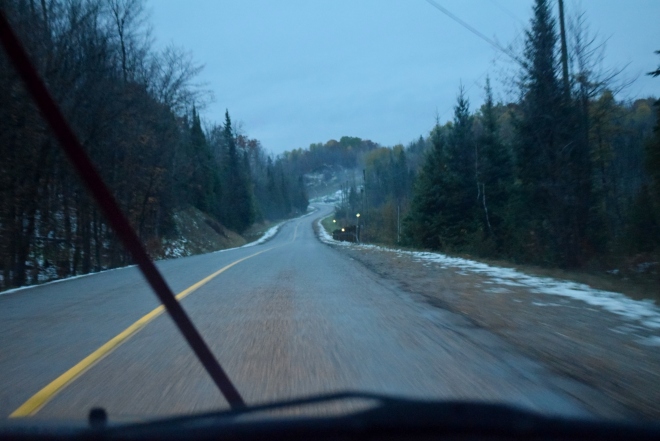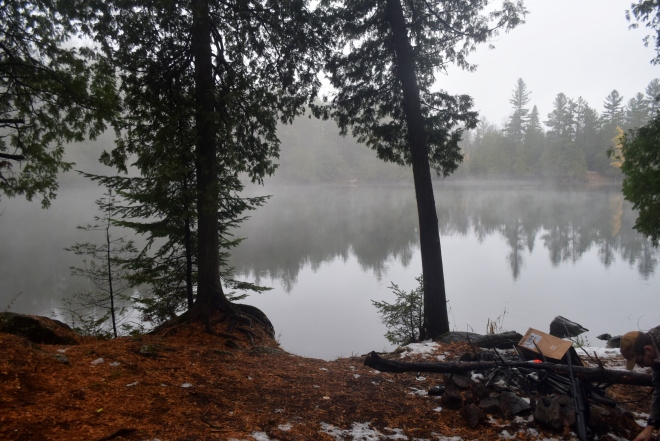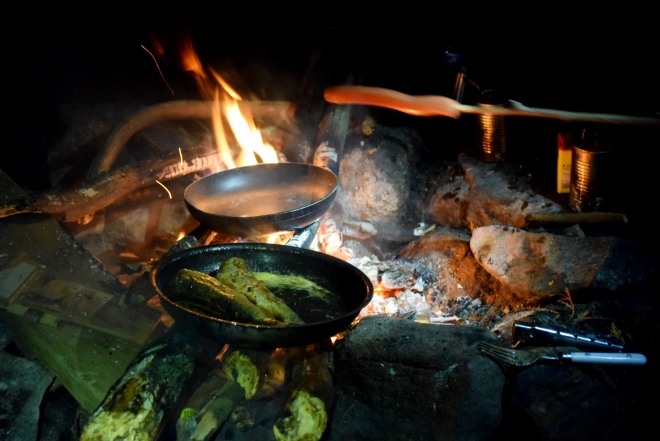(Trigger Warning: I hunt, this blog includes posts on hunting, as such this post contains pictures of harvested deer. Please avoid if this is unsettling to you.)
Sometimes things just work out. I mean there are lots of times where life throws you curveballs and nothing works (cough, last years deer season), but then there are the times where things just click and all feels right with the world.
I had a feeling that the 2016 deer season was just such a time. It was a new year ripe with possibilities, and despite a poor success rate in 2015, I remained more optimistic than ever. With a warm winter at our backs, a good recruitment of fawns expected, and an unheard-of three doe tags in our collective pockets, visions of many tagged deer danced in my mind. This was a pretty great way to feel hiking out to a deer stand at the beginning of the season.
Some hunters talk about conjuring deer from an internal sense of desire, other people talk about positivity bearing fruit. Heck maybe it all comes down to the great Ju-Ju, and how many times you rub the rack of antlers over the camps fireplace before you start the day. Call it what you want, but what ever it was I had it on the first day. About 10 minutes after sitting down, a good sized doe cantered out from the corner of a nearby field right into my field of vision and the sights of my Tikka .270. I whistled to stop her as she ran, took my shot, and just like that, our group had our first deer down for the year. Sometimes things just work out!


Having harvested a deer on the first day, left me with a strange feeling. All my past experiences with deer season usually involved several days of little to no action right off the bat. This inactivity equates to build up in anxiety, and anticipation. One that is gradual and goes unnoticed but usually culminates with a rush of adrenaline once a deer is actually harvested late in the season. This is not the case for the punctual deer shot right off the bat. This deer comes with a strange lack of excitement, and a sense of relief. Knowing that the first deer is down and that the group will have venison for the winter is as relieving as it gets. Although not as exciting, harvesting the first deer so quickly sure makes it easier to sit in the stand for the rest of the week. Maybe its not so complicated, maybe its just the ramblings of a successful hunter who has spent too much time in a back up stand.

But enough rambling, lets talk about the season. Generally, as deer seasons go, this one sits firmly in my top 5. Heck, my top 2 for that matter. Its takes second place for the number of deer I personally harvested, and first place for the level of success we as a group had. With an average of one deer per day, and six in total, the season was action packed an hard to beat. Not to mention the quality of the deer just seemed to get better and better as the week carried on.

 The first three deer were does, filling our coveted doe tags and forcing us to take amore buck centric mind set. This was tough to do with the number of does that just kept presenting themselves to us. Luckily Jordan managed a shot at a tricky buck who was trying to sneak by in a marshy area. Buck one was down and day three was over.
The first three deer were does, filling our coveted doe tags and forcing us to take amore buck centric mind set. This was tough to do with the number of does that just kept presenting themselves to us. Luckily Jordan managed a shot at a tricky buck who was trying to sneak by in a marshy area. Buck one was down and day three was over.
Day four started off with a low key run on a property that was divided into two sections. We ran the first area with no sightings of live deer but plenty of deer sign for the seeing. Following the unsuccessful initial run, we moved to the second adjacent property, thinking that perhaps the buck whose sign we were seeing could be present. As luck would have it, he was, and as I trucked on into the farthest stand I heard the sound off a rifle from one of our group. Eric had been laying in wait at a pinch point within the property in anticipation that something may be pushed as we travelled to our stands. This would be our second buck and the biggest I had yet to see in my relatively short time as a deer hunter.
(Eric hadn’t harvested a buck in a while, so it was nice to see him have success with such a beast of an animal)


This deer was healthy, and Eric was beaming. According to the group, It had been a few years since something this big had come out of the woods. Big, but not the end of the story.
Day five arrived, and it was my turn to dog the bush. My previous dogging experience had been limited to a small section of woods as a way to ease me into the game. Having already harvested a deer, and having fresh young legs made me a prime candidate to run the dogs a couple times. So the group set me up on a larger stretch of bush, followed by a smaller tighter bush. At the time, I wasn’t too impressed with the prickly ash present on the first property. Who would be. But contemplating the whole experience I’ve realized this is a part of deer hunting and you have to put the work in to reap the rewards. Apparently I put a whole lot of work in, because the reward on the second run was pretty epic. I was quick to note that due to my success, I may actually be the best dogger to ever enter those woods. That claim was short lived as the group started mulling over the concept of having me dog on a full time basis. Back to being average!

A few minutes into the run I dogged a small section of swampy woods located next to the roadway. Apparently the deer had been using this as a throughway to get across the street to the adjacent cornfields. I must have some innate knack for dogging as I inadvertently managed to send a bruiser of a buck back towards the other hunters in their stands. This big boy was the last and biggest of the week. Bigger than Eric’s the day before, and bigger than anything I had ever seen in person. A true southern Ontario giant.

(There was no way we were carrying this guy out of the bush. As is, it took a few of the lads to lift this beast onto the four wheeler.)

The veterans in the group immediately started into a conversation about whether or not this was the biggest ever deer taken on the property. The veterans measured the buck with there aged discerning eyes and mentally compared this trophy against the bucks of old. To my surprise and amazement, this buck didn’t even break the top 5. As unbelievable as it sounds, bigger bucks had been taken on the properties we hunted. And in the groups opinion, bigger bucks would be had in the future. Regardless of this, the one thing the whole group agreed upon was that the past years had been very tough and this year had been a return to past glories. I was left confounded, feeling like as much as I had seen in my past 5-6 years of deer hunting, I had yet to even scratch the surface…

(The reality of the situation became very apparent when the three bucks were stacked up side by side.)

(the author with the larger than life buck harvested by the youngest of our group)
We did a last run Saturday morning, albeit half heartedly. With the success we had it was unlikely that the group would actually shoot another deer. I think deep down we all know when its time to call it a day. Besides, with six deer hanging, we had a long day of work ahead of us.

This was a year for the history books, and a year to fill freezers with prized venison. I’m left with a sense of satisfaction that comes with having a full freezer. This can often be accompanied by a sense of loss, or depletion, a feeling that we had ransacked the woods and left things in shambles. This was not the case this year. My view remained positive as the number of predators seen was way down, the number of deer seen was way up, and better still, the number of deer seen that we didn’t harvest far outweighed the number we shot. It seems we are in an upswing of the deer cycle in this part of 67. The sentimental part of me feels like I’m living the soon to be good old days. And when I’m old and grey, sitting on my porch telling stories of my life gone by to semi interested relatives, this week will likely be one of those stories.
























 The first three deer were does, filling our coveted doe tags and forcing us to take amore buck centric mind set. This was tough to do with the number of does that just kept presenting themselves to us. Luckily Jordan managed a shot at a tricky buck who was trying to sneak by in a marshy area. Buck one was down and day three was over.
The first three deer were does, filling our coveted doe tags and forcing us to take amore buck centric mind set. This was tough to do with the number of does that just kept presenting themselves to us. Luckily Jordan managed a shot at a tricky buck who was trying to sneak by in a marshy area. Buck one was down and day three was over.



























